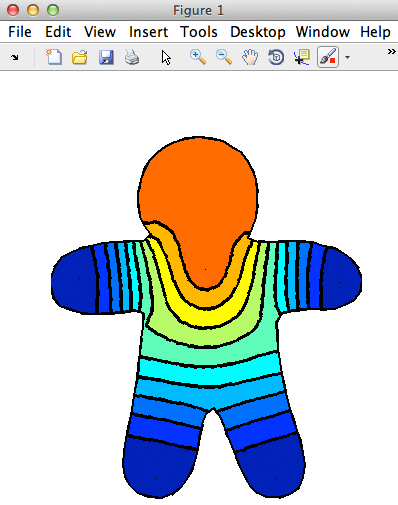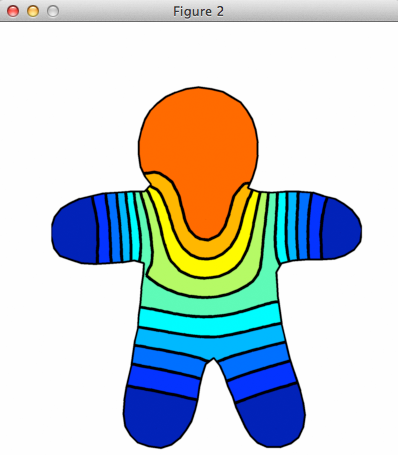Isoline plots on triangle meshes in Matlab
Alec Jacobson
March 09, 2012
I recently posted how to plot nice looking iso intervals of scalar fields on triangle meshes using matlab. Along with the intervals I gave an ad hoc way of also showing isolines. This works ok if your data has fairly uniform gradient but they're not really isolines.
Here's a little matlab function to output real isolines. Save it in a file called isoline.m:
function [LS,LD,I] = isolines(V,F,S,iso)
% ISOLINES compute a list of isolines for a scalar field S defined on the
% mesh (V,F)
%
% [LS,LD,I] = isolines(V,F,S,iso)
%
% Inputs:
% V #V by dim list of vertex positions
% F #F by 3 list of triangle indices
% S #V list of scalar values defined on V
% iso #iso list of iso values
% Outputs:
% LS #L by dim list of isoline start positions
% LD #L by dim list of isoline destination positions
% I #L list of indices into iso revealing corresponding iso value
%
% alternative: tracing isolines should result in smaller plot data (every
% vertex only appears once
%
% make sure iso is a ROW vector
iso = iso(:)';
% number of isolines
niso = numel(iso);
% number of domain positions
n = size(V,1);
% number of dimensions
dim = size(V,2);
% number of faces
m = size(F,1);
% Rename for convenience
S1 = S(F(:,1),:);
S2 = S(F(:,2),:);
S3 = S(F(:,3),:);
% t12(i,j) reveals parameter t where isovalue j falls on the line from
% corner 1 to corner 2 of face i
t12 = bsxfun(@rdivide,bsxfun(@minus,iso,S1),S2-S1);
t23 = bsxfun(@rdivide,bsxfun(@minus,iso,S2),S3-S2);
t31 = bsxfun(@rdivide,bsxfun(@minus,iso,S3),S1-S3);
% replace values outside [0,1] with NaNs
t12( (t12<-eps)|(t12>(1+eps)) ) = NaN;
t23( (t23<-eps)|(t23>(1+eps)) ) = NaN;
t31( (t31<-eps)|(t31>(1+eps)) ) = NaN;
% masks for line "parallel" to 12
l12 = ~isnan(t23) & ~isnan(t31);
l23 = ~isnan(t31) & ~isnan(t12);
l31 = ~isnan(t12) & ~isnan(t23);
% find non-zeros (lines) from t23 to t31
[F12,I12,~] = find(l12);
[F23,I23,~] = find(l23);
[F31,I31,~] = find(l31);
% indices directly into t23 and t31 corresponding to F12 and I12
%ti12 = sub2ind(size(l12),F12,I12);
%ti23 = sub2ind(size(l23),F23,I23);
%ti31 = sub2ind(size(l31),F31,I31);
% faster sub2ind
ti12 = F12+(I12-1)*size(l12,1);
ti23 = F23+(I23-1)*size(l23,1);
ti31 = F31+(I31-1)*size(l31,1);
% compute actual position values
LS = [ ...
... % average of vertex positions between 2 and 3
bsxfun(@times,1-t23(ti12), V(F(F12,2),:)) + ...
bsxfun(@times, t23(ti12), V(F(F12,3),:)) ...
; ... % average of vertex positions between 2 and 3
bsxfun(@times,1-t31(ti23), V(F(F23,3),:)) + ...
bsxfun(@times, t31(ti23), V(F(F23,1),:)) ...
;... % average of vertex positions between 2 and 3
bsxfun(@times,1-t12(ti31), V(F(F31,1),:)) + ...
bsxfun(@times, t12(ti31), V(F(F31,2),:)) ...
];
LD = [...
... % hcat with average of vertex positions between 3 and 1
bsxfun(@times,1-t31(ti12), V(F(F12,3),:)) + ...
bsxfun(@times, t31(ti12), V(F(F12,1),:)) ...
;... % hcat with average of vertex positions between 3 and 1
bsxfun(@times,1-t12(ti23), V(F(F23,1),:)) + ...
bsxfun(@times, t12(ti23), V(F(F23,2),:)) ...
;... % hcat with average of vertex positions between 3 and 1
bsxfun(@times,1-t23(ti31), V(F(F31,2),:)) + ...
bsxfun(@times, t23(ti31), V(F(F31,3),:)) ...
];
% I is just concatenation of each I12
I = [I12;I23;I31];
end
Then if you have a mesh in (V,F) and so scalar data in S. You can display isolines using:
colormap(jet(nin));
trisurf(F,V(:,1),V(:,2),V(:,3),'CData',S,'FaceColor','interp','FaceLighting','phong','EdgeColor','none');
axis equal;
[LS,LD,I] = isolines(V,F,S,linspace(min(S),max(S),nin+1));
hold on;
plot([LS(:,1) LD(:,1)]',[LS(:,2) LD(:,2)]','k','LineWidth',3);
hold off
set(gcf, 'Color', [1,1,1]);
set(gca, 'visible', 'off');
%O = outline(F);
%hold on;
%plot([V(O(:,1),1) V(O(:,2),1)]',[V(O(:,1),2) V(O(:,2),2)]','-k','LineWidth',2);
%hold off
Uncomment the last lines to display the outline of the mesh. This produces:

If you use the my anti-alias script you can get pretty good results, almost good enough for a camera-ready paper:



